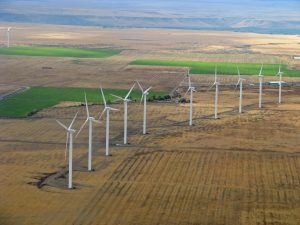The Inflation Reduction Act (IRA) is expected to boost the U.S. economy, strengthen American energy security, and reduce greenhouse gas emissions by 40% by 2030. It is a big step in the right direction to investing in a clean energy future. Here’s a breakdown of what this means for Idahoans.
Lower cost for solar, consumers, and utilities
For the Idaho homeowner, the IRA covers 30% of the costs to install solar panels, battery storage systems, and home energy efficiency improvements, as well as upgrades to heating and cooling systems. According to a White House press release, 50,000 Idaho households are projected to install solar panels. Rebates will cover 50-100% of the cost of installing new energy efficient appliances including super-efficient heat pumps, water heaters, clothes dryers, stoves, and ovens. The bill focuses on including low and moderate-income households.
The White House press release for Idaho also states, “the IRA includes tax credits that cover 30% of the costs of community solar projects — owned by local businesses that sign up families to save on their electric bills — with additional bonus credits of 20% for projects at affordable housing properties and 10% for projects in low-income communities.”
New IRA financing can also be used by utilities to reduce the costs of closing fossil fired power plants, allowing utilities to invest in more renewable energy without raising energy rates for customers. The investment firm, Morgan Stanley, asserts that transitioning the use of capital from maintaining the fossil fuel industry to investing in clean energy projects will not only lower emissions and create cheaper power, but that clean energy investment will also earn higher ratings.

Providing business certainty and zero-emissions technology
The IRA will give developers, investors, manufacturers, and utilities access to tax credits for renewable energy facilities and projects for a minimum of 10 years. The value of those tax credits will only decline after the power sector has cut greenhouse gas emissions by 75% from today’s levels, preventing the renewable energy industry from experiencing the periodic boom-bust cycles.
In Idaho more than 13,000 people are currently employed in the solar, wind, storage, and other clean energy industries. Over the next eight years, the IRA will create many new local jobs with an infusion of about $320 million for energy storage projects and large-scale clean power generation. Additional tax credits give incentive for clean energy project developers to include worker training and competitive wage conditions, as well as to source their components from US manufacturers.
The IRA allows existing zero-carbon producing nuclear power plants to continue producing electricity. Over the next 10 years, more distributed electrical generation will come online, making transmission and distribution upgrades necessary. The IRA provides for planning, negotiation, and construction of new transmission lines and corridors. Additionally, the investment tax credits can now be used to develop non-ag carbon-capture and hydrogen powered technologies as well as for energy storage.
Idaho Power has announced plans to bring online Idaho’s first utility scale storage system located near Melba, by the summer of 2023. This 120 megawatt system can power 42,000 homes and will be able to receive IRA funding, allowing power rates to remain low.
Rural co-ops, cash grants, and transferable tax credits
In Idaho, nearly 100,000 homes are served by rural electric cooperatives. These cooperatives, as well as municipal utilities, are eligible for cash grants and direct-pay clean energy tax credits when they invest in clean energy and efficiency upgrades that increase their resiliency, reliability, and affordability. In addition, energy developers can sell unused tax credits to anyone with a tax liability, circumventing the wasteful red-tape experiences in the past.

Small businesses, agriculture, and forests
Through the IRA, commercial business owners will be able to receive a tax credit up to $5 per square foot to support energy efficiency improvements that lower their electricity bills. Small businesses are also eligible for a tax credit covering 30% of their cost to install solar power and purchase clean power vehicles for company fleets.
Idaho’s 25,000 farms are eligible for support when they follow climate-smart agriculture practices, conservation, and stewardship that create healthy nutrient-dense soils. The IRA also includes funding for investments in strengthening Idaho’s natural forest resources, from wildfire prevention efforts to tree planting projects that protect cities from extreme heat.
Electric vehicles and charging stations
In August of 2022, the Idaho State Office of Energy and Minerals completed plans to build out EV charging stations along major and minor highways throughout Idaho using funding from the Bipartisan Infrastructure Law. Constructing these chargers will put EV range anxiety in the rearview mirrors of Idahoans.
While supply chain issues continue to make electric vehicles difficult to purchase, the IRA contains a number of exciting electric vehicle provisions that begin December 31, 2022 and end in ten years. The IRA lifts the 200,000 cap on the number of vehicles that are eligible for tax breaks or discounts. Now, there are up-front discounts of up to $7500 that can be used for new passenger and light duty EVs and $4000 for used EVs. There are some stipulations — there’s a buyer income limit, the vehicle must be assembled in the U.S., and new cars must be constructed with domestically mined or recycled minerals.

Businesses can use two IRA provisions for the purchase of EVs and chargers. The Clean Commercial Vehicle Credit provides up to $40,000 in tax breaks for businesses that purchase new or used medium and heavy-duty electric vehicles. The Alternative Fuel Vehicle Refueling Property Credit allows a tax credit of up to $100,000 for charging equipment that is installed in areas where the poverty rate is at least 20 percent or where the median family income is equal to or less than $41,780*.
Additionally, the IRA supports new transportation projects and planning against extreme weather events through a new Neighborhood Access and Equity Grant Program.
Tribal community funding
The IRA includes funding for Tribal climate resilience including fish hatchery operations and maintenance, Tribal home electrification, and emergency drought relief.
What is still needed?
Idahoans could see more positive impacts from the IRA – if the Idaho legislature were to pass ambitious clean energy targets. This could help both regulators and utilities capitalize on federal support.
Idaho also needs to protect its Energy Conservation Codes, which promote efficiency for homes and businesses in Idaho and ensure we all have safe, healthy, and comfortable places to live and work. Idaho’s Division of Occupational and Professional Licenses has been moving to eliminate these vital requirements – and if this happens, Idaho would not be eligible for some federal grants to promote energy efficient buildings. Now is the time to let Idaho officials know that you care about safe and affordable homes and businesses, take action below!
